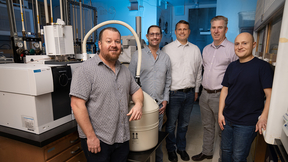W87-1 Modification Program enters Phase 6.3, Development Engineering
 (Download Image)
(Download Image)
Engineers at Lawrence Livermore National Laboratory’s new Facility for Advanced Manufacturing work on equipment for large-scale 3D printing of high explosives suitable for hydrodynamic testing. (Photo by Garry McLeod)
The Department of Energy’s National Nuclear Security Administration (NNSA) and the Department of Defense (DoD) recently approved the W87-1 Modification Program to enter Phase 6.3, Development Engineering, through the Nuclear Weapons Council. During this phase of the nuclear weapons lifecycle process, NNSA will continue to work closely with DoD to conduct experiments, tests and analyses to develop and validate the selected design option. During Phase 6.3, the national laboratories have been initiating and continuing product development activities and producing test hardware, as required.
The W87-1 is slated for deployment in the early 2030s, alongside the W87-0 warhead on the Sentinel intercontinental ballistic missile (ICBM), formerly known as the Ground-Based Strategic Deterrent (GBSD). The W87-1 will replace the aging W78 warhead by deploying a modified version of the legacy W87-0 design. Following authorization from the Nuclear Weapons Council in September 2018, the W87-1 restarted Phase 6.2, Feasibility Study and Design Options, in January 2019. The program completed Phase 6.2 and entered Phase 6.2A, Design Definition and Cost Study, in the fourth quarter of FY 2021.
“Reaching Phase 6.3 for the W87-1 Modification program is an important milestone for the warhead program as we remain synchronized with the US Air Force for the Sentinel program and development of the updated Mark 21A reentry vehicle. Delivery of this warhead, planned to be 100% newly manufactured, will be an important step in the modernization of the nation’s nuclear deterrent,” said Marvin Adams, NNSA deputy administrator for Defense Programs.
As a lead design agency for the nuclear explosive package for the W87-1, the program is finding that their efforts also are transforming the Nuclear Security Enterprise in important, lasting ways, said Brad Wallin, principal associate director for LLNL’s Weapons and Complex Integration directorate.
“The changes we are making to the W87-1 are possible due to the unique, diverse tools of science-based stockpile stewardship, allowing the new warhead to be confidently certified without nuclear testing,” Wallin said. “The W87-1 program is also pursuing innovative, transformational partnerships across the Nuclear Security Enterprise to introduce new materials, manufacturing techniques, and processes to meet W87-1 and future stockpile systems requirements.”
New survivability testing capabilities enabled at the National Ignition Facility will support new materials and component designs. Further, El Capitan, NNSA’s first exascale computer, planned for deployment at Lawrence Livermore National Laboratory, will provide high-resolution simulations to validate weapon designs.
As the design agency for the nuclear explosive package for the W87-1, Lawrence Livermore researchers are spearheading new partnerships to innovate materials development and manufacturing techniques, said Juliana Hsu, LLNL program manager for the W87-1 Warhead Modification Program.
Building on the progress from previous modernization programs, the design agencies — Lawrence Livermore and Sandia National Laboratories — and the production agencies — Los Alamos National Laboratory, Savannah River Site, Kansas City National Security Campus, Y-12 National Security Complex, Pantex Plant, and key NNSA material supplier, Holston Army Ammunition Plant — are collaborating more closely than ever. This includes enhancing the integration across NNSA to establish appropriate project controls. Strong partnerships with the U.S. Air Force, Lockheed Martin and Northrop Grumman are key to having a reliable deterrent based on the Sentinel ICBM and the Mk21A reentry vehicle that will deliver the W87-1 warhead.
“Strong collaboration and partnership between design and production agencies across the Nuclear Security Enterprise will play a key role in the continued progress of the W87-1 as the program progresses in Phase 6.3,” Hsu said.
The W87-1 will meet DoD and DOE/NNSA requirements for performance, safety and security. The modernization program will provide enhanced safety and security compared to the legacy W78, but does not provide new military capabilities, and will be certified without the need for additional underground nuclear explosive testing.
To learn more, read the December 2022 issue of Science and Technology Review, featuring the W87-1 Modification Program.
Contact
 Paul Rhien
Paul Rhien
[email protected]
(925) 422-4206
Related Links
Department of DefenseNational Nuclear Security Administration
Tags
DefenseStrategic Deterrence
Featured Articles







